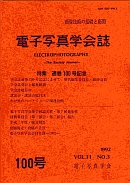Volume 31, Issue 1
Displaying 1-12 of 12 articles from this issue
- |<
- <
- 1
- >
- >|
-
1992Volume 31Issue 1 Pages 2-10
Published: 1992
Released on J-STAGE: June 06, 2007
Download PDF (2050K) -
1992Volume 31Issue 1 Pages 11-15
Published: 1992
Released on J-STAGE: June 06, 2007
Download PDF (765K) -
1992Volume 31Issue 1 Pages 16-25
Published: 1992
Released on J-STAGE: June 06, 2007
Download PDF (2022K) -
1992Volume 31Issue 1 Pages 26-31
Published: 1992
Released on J-STAGE: June 06, 2007
Download PDF (1122K) -
1992Volume 31Issue 1 Pages 32-39
Published: 1992
Released on J-STAGE: June 06, 2007
Download PDF (1927K) -
1992Volume 31Issue 1 Pages 40-45
Published: 1992
Released on J-STAGE: June 06, 2007
Download PDF (703K) -
1992Volume 31Issue 1 Pages 46-52
Published: 1992
Released on J-STAGE: June 06, 2007
Download PDF (1763K) -
1992Volume 31Issue 1 Pages 53-59
Published: 1992
Released on J-STAGE: June 06, 2007
Download PDF (1473K) -
1992Volume 31Issue 1 Pages 60-68
Published: 1992
Released on J-STAGE: June 06, 2007
Download PDF (1271K) -
1992Volume 31Issue 1 Pages 70-76
Published: 1992
Released on J-STAGE: June 06, 2007
Download PDF (921K) -
1992Volume 31Issue 1 Pages 77-81
Published: 1992
Released on J-STAGE: June 06, 2007
Download PDF (677K) -
1992Volume 31Issue 1 Pages 82-86
Published: 1992
Released on J-STAGE: June 06, 2007
Download PDF (1602K)
- |<
- <
- 1
- >
- >|
